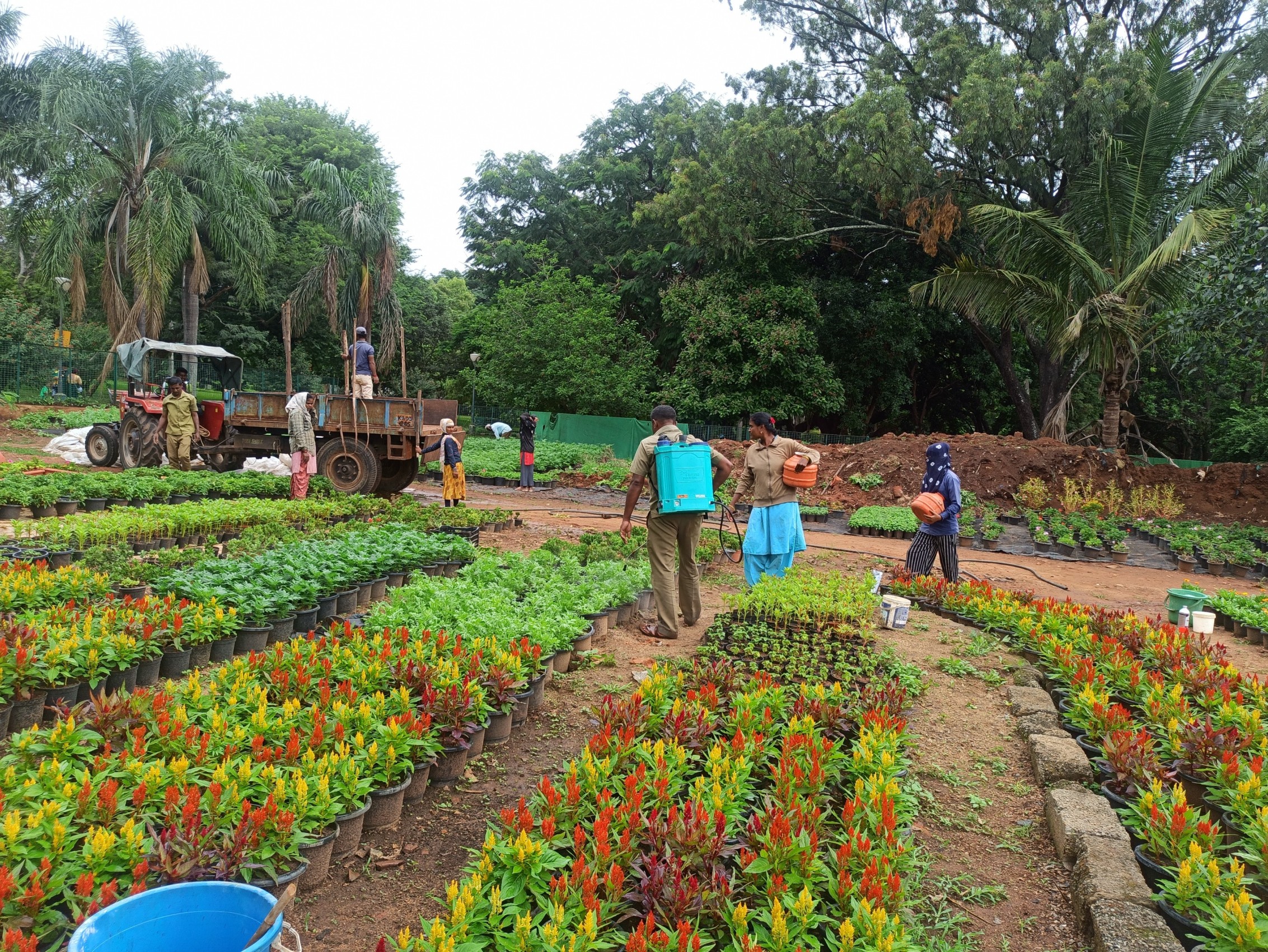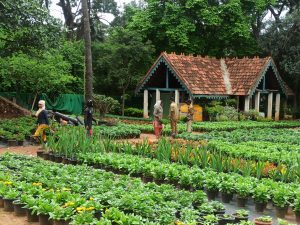The Flower Show at Lalbagh attracts millions, but the real heroes of the show remain far removed from the public gaze.
Published Jul 21, 2024 | 4:00 PM ⚊ Updated Jul 21, 2024 | 6:13 PM

Garderners of Lalbagh, the real heros behind the scenes. (Deeksha Devadiga/South First)
Every January and August, the glasshouse at Lalbagh Botanical Gardens in Bengaluru transforms into a vibrant tapestry of colours and fragrances, drawing a million visitors.

The biannual Lalbagh Flower Show is a spectacle of horticultural artistry.
(Deeksha Devadiga/South First)
The biannual Lalbagh Flower Show is a spectacle of horticultural artistry, showcasing thousands of flowers arranged in stunning displays. Yet, behind this breathtaking event lies the unwavering dedication and hard work of Lalbagh’s gardeners, the true heroes of this floral extravaganza.
The Lalbagh Flower Show has a rich history, rooted in the British era. The event began in the 19th century, with small-scale flower shows held in the Bandstand area.
The construction of the iconic glasshouse in 1889 marked a turning point, providing a venue to host more elaborate displays.
Since then, the flower show has become an integral part of Bengaluru’s cultural heritage. It is organised twice a year by the Mysore Horticultural Society, established in 1912 by GH Krumbiegel.
This year marks the 216th iteration of the show, which has seen only a handful of cancellations throughout its history.
The flower show was paused during the plague outbreak, the kidnapping of Kannada actor Rajkumar, and most recently, during the Covid-19 pandemic.
At the helm of this massive endeavour is Jagadeesh, the Director of Horticulture at Lalbagh.
With years of experience and a deep passion for horticulture, Jagadeesh oversees the planning and execution of the flower show.
“This year’s theme is a floral tribute to Dr Babasaheb Ambedkar,” he explains, “depicting his life story and contributions through intricate floral arrangements.”
The centerpiece of this year’s show is a stunning floral replica of the Parliament House, drawing inspiration from India’s rich history and culture.
While the grandeur of the flower show captivates visitors, it is the gardeners who breathe life into this event.
Gangamma, a gardener at Lalbagh for 25 years, travels daily to Bengaluru from Doddaballapura, more than 40 km away.
“I got this job after my husband passed away,” she said, her voice tinged with both pride and resilience. Her day begins at 8 am, meticulously tending to the plants, removing weeds, and ensuring that every flower blooms to its fullest.
For Dilip, another dedicated gardener, the journey is equally challenging.
Travelling from Chikkaballapura, he joins his colleagues in the painstaking process of preparing flowerbeds, spraying pesticides, and applying essential nutrients.
“We start our primary activities almost four and a half months ahead of the show,” said Manjunath, the Horticulture Assistant. “It’s crucial to synchronise the blooming period of different flowers.”
The preparation for the flower show is a complex, coordinated effort involving around 150 permanent gardeners and numerous contract workers.
They work tirelessly, mowing lawns, cleaning grow beds, and ensuring that every flower is perfect.
The final month before the show sees an influx of artists, experts, and additional workers, bringing the total workforce to around 1,500.
Despite meticulous planning, nature can be unpredictable. Manjunath revealed. “We have backup plans and chemicals like flower boosters to ensure the flowers bloom on time.”
The gardeners’ commitment goes beyond mere duty; they treat each plant with the care one would give to a child, nurturing them with patience and love.
As the show unfolds from 8 – 19 August, visitors marvel at the floral displays, unaware of the months of hard work behind them.
The gardeners’ efforts are evident in every petal, every arrangement, and every intricate detail.
The floral replicas of historical monuments, the thematic displays, and the vibrant carpets of flowers are testaments to their dedication.
Once the show concludes, the work doesn’t stop. The cleanup process takes 10 to 15 days, during which broken pots are replaced, and flowers past their prime are composted.
“Some flowers are taken back to the nursery, while others are used as organic manure,” explains Manjunath.
The cycle begins anew, with preparations starting almost immediately for the next show in January.
For the gardeners of Lalbagh, this is more than just a job. It is a labour of love, a source of pride, and a lifelong commitment to their craft.
Gangamma at 58 is nearing retirement. She dreams of tending to her cows post-retirement, but for now, she finds joy in the blooming flowers that she has nurtured.
Veena, a newer addition to the team, brings fresh enthusiasm, having recently completed her training in horticulture.
These gardeners, with their calloused hands and tireless spirits, are the unsung heroes of the Lalbagh Flower Show.
Their stories, woven into the fabric of each flower bed, remind us of the human touch behind the botanical marvels.
As visitors stroll through the vibrant displays, they witness not just the beauty of nature, but the culmination of months of dedication, passion, and unwavering commitment of the gardeners of Lalbagh.
(Edited by Majnu Babu)
(South First is now on WhatsApp and Telegram)
